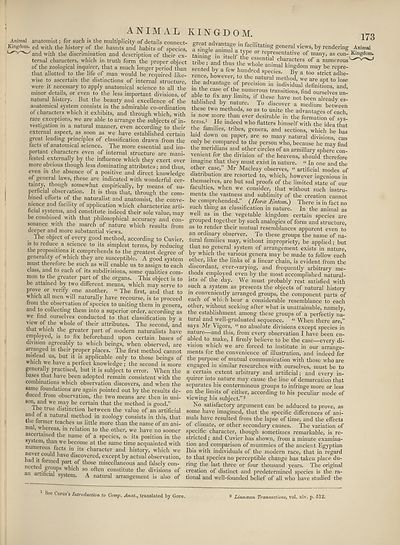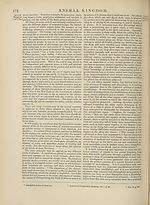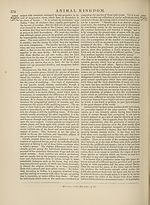Encyclopaedia Britannica > Volume 3, Anatomy-Astronomy
(181) Page 173
Download files
Complete book:
Individual page:
Thumbnail gallery: Grid view | List view

Animal anatomist; for such is the multiplicity of details connect-
Kingdom. e{i with the history of the haunts and habits of species,
and with the discrimination and description of their ex¬
ternal characters, which in truth form the proper object
of the zoological inquirer, that a much longer period than
that allotted to the life of man would be required like¬
wise to ascertain the distinctions of internal structure,
were it necessary to apply anatomical science to all the
minor details, or even to the less important divisions, of
natural history. But the beauty and excellence of the
anatomical system consists in the admirable co-ordination
of characters which it exhibits, and through which, with
rare exceptions, we are able to arrange the subjects of in¬
vestigation in a natural manner, even according to their
external aspect, as soon as we have established certain
great leading principles of classification drawn from the
facts of anatomical science. The more essential and im¬
portant characters even of internal structure ai'e mani¬
fested externally by the influence which they exert over
more obvious though less dominating attributes; and thus,
even in the absence of a positive and direct knowledge
of general laws, these are indicated with wonderful cer¬
tainty, though somewhat empirically, by means of su¬
perficial observation. It is thus that, through the com¬
bined efforts of^ the naturalist and anatomist, the conve¬
nience and facility of application which characterize arti¬
ficial systems, and constitute indeed their sole value, may
be combined with that philosophical accuracy and con¬
sonance with the march of nature which results from
deeper and more substantial views.
The object of every good method, according to Cuvier,
is to i educe a science to its simplest terms, by reducing
the propositions it comprehends to the greatest degree of
generality of which they are susceptible. A good system
must thei efore be such as will enable us to assign to each
class, and to each of its subdivisions, some qualities com¬
mon to the greater part of the organs. This object is to
be attained by two different means, which may serve to
prove or verify one another. “ The first, and that to
which all men will naturally have recourse, is to proceed
from the observation of species to uniting them in genera,
and to collecting them into a superior order, according as
we find ourselves conducted to that classification by a
view of the whole of their attributes. The second, and
that which the greater part of modern naturalists have
employed, is to fix beforehand upon certain bases of
division agreeably to which beings, when observed, are
arranged in their proper places. The first method cannot
mislead us, but it is applicable only to those beings of
which we have a perfect knowledge ; the second is more
generally practised, but it is subject to error. When the
bases that have been adopted remain consistent with the
combinations which observation discovers, and when the
same foundations are again pointed out by the results de¬
duced from observation, the two means are then in uni-
son, and we may be certain that the method is good.”
The true distinction between the value of an artificial
and of a natural method in zoology consists in this, that
the former teaches us little more than the name of an ani-
ma, whereas, in relation to the other, we have no sooner
ascertained the name of a species, o. its position in the
system, than we become at the same time acquainted with
numerous facts in its character and history, which we
never cou d have discovered, except by actual observation,
lat it ormed part of those miscellaneous and falsely con¬
nected groups which so often constitute the divisions of
an artificial system. A natural arrangement is also of
ANIMAL KINGDOM.
fTi^Vai1 ta^e ’n facilitating general views, by rendering
tabdnl ?nmva i? APe °r rePresentative of many, as con-
tdhe gnnd tfiSeVhe ?Tntial characters of a numerous'
tribe, and thus the whole animal kingdom may be repre¬
sented by a few hundred species. By a too s^t adhe¬
rence, however, to the natural method, we are apt to lose
the advantage of precision in individual definitions, and,
m the case of the numerous transitions, find ourselves un-
fbnf \° Jx,any llmits> if these have not been already es¬
tablished by nature. To discover a medium between
these two methods, so as to unite the advantages of each
is now more than ever desirable in the formation of sysl
^ras; .^e ind?ed who flatters himself with the idea that
the families, tribes, genera, and sections, which he has
laid down on paper, are so many natural divisions, can
only be compared to the person who, because he may find
the meridians and other circles of an armillary sphere con¬
venient for the division of the heavens, should therefore
imagine that they must exist in nature. “ In one and the
other case,” Mr Macleay observes, “ artificial modes of
distribution are resorted to, which, however ingenious in
themselves, are but sad proofs of the limited state of our
faculties, when we consider, that without such instru¬
ments the vastness and sublimity of the creation cannot
be comprehended.” (Horce Entom.) There is in fact no
such thing as classification in nature. In the animal as
well as in the vegetable kingdom certain species are
grouped together by such analogies of form and structure,
as to render their mutual resemblances apparent even to
an ordinary observer. To these groups the name of na¬
tural families may, without impropriety, be applied; but
that no general system of arrangement exists in nature,
by which the various genera may be made to follow each
other, like the links of a linear chain, is evident from the
discordant, ever-varying, and frequently arbitrary me¬
thods employed even by the most accomplished natural¬
ists of the day. We must probably rest satisfied with
such a system as presents the objects of natural history
in conveniently arranged groups, the component parts of
each of whi h bear a considerable resemblance to each
other, without seeking after what is unattainable, namely,
the establishment among these groups of a perfectly na-
tui al and well-graduated sequence. “ When there are,”
says Mr Vigors, “ no absolute divisions except species in
nature—and this, from every observation I have been en-
abled to make, I firmly believe to be the case—every di¬
vision which we are forced to institute in our arrange¬
ments for the convenience of illustration, and indeed for
the purpose of mutual communication with those who are
engaged in similar researches with ourselves, must be to
a certain extent arbitrary and artificial; and every in¬
quirer into nature may cause the line of demarcation that
separates his conterminous groups to infringe more or less
on the limits of either, according to his peculiar mode of
viewing his subject.”2
No satisfactory argument can be adduced to prove, as
some have imagined, that the specific differences of ani¬
mals have resulted from the lapse of time, and the effects
of climate, or other secondary causes. The variation of
specific character, though sometimes remarkable, is re¬
stricted ; and Cuvier has shown, from a minute examina¬
tion and comparison of mummies of the ancient Egyptian
Ibis with individuals of the modern race, that in regard
to that species no perceptible change has taken place du¬
ring the last three or four thousand years. The original
creation of distinct and predetermined species is the ra¬
tional and well-founded belief of all who have studied the
173
Animal
Kingdom.
See Car us s Introduction to Comp. Anat., translated by Gore.
2 Linncean Transactions, vol. xiv. p. 512.
Kingdom. e{i with the history of the haunts and habits of species,
and with the discrimination and description of their ex¬
ternal characters, which in truth form the proper object
of the zoological inquirer, that a much longer period than
that allotted to the life of man would be required like¬
wise to ascertain the distinctions of internal structure,
were it necessary to apply anatomical science to all the
minor details, or even to the less important divisions, of
natural history. But the beauty and excellence of the
anatomical system consists in the admirable co-ordination
of characters which it exhibits, and through which, with
rare exceptions, we are able to arrange the subjects of in¬
vestigation in a natural manner, even according to their
external aspect, as soon as we have established certain
great leading principles of classification drawn from the
facts of anatomical science. The more essential and im¬
portant characters even of internal structure ai'e mani¬
fested externally by the influence which they exert over
more obvious though less dominating attributes; and thus,
even in the absence of a positive and direct knowledge
of general laws, these are indicated with wonderful cer¬
tainty, though somewhat empirically, by means of su¬
perficial observation. It is thus that, through the com¬
bined efforts of^ the naturalist and anatomist, the conve¬
nience and facility of application which characterize arti¬
ficial systems, and constitute indeed their sole value, may
be combined with that philosophical accuracy and con¬
sonance with the march of nature which results from
deeper and more substantial views.
The object of every good method, according to Cuvier,
is to i educe a science to its simplest terms, by reducing
the propositions it comprehends to the greatest degree of
generality of which they are susceptible. A good system
must thei efore be such as will enable us to assign to each
class, and to each of its subdivisions, some qualities com¬
mon to the greater part of the organs. This object is to
be attained by two different means, which may serve to
prove or verify one another. “ The first, and that to
which all men will naturally have recourse, is to proceed
from the observation of species to uniting them in genera,
and to collecting them into a superior order, according as
we find ourselves conducted to that classification by a
view of the whole of their attributes. The second, and
that which the greater part of modern naturalists have
employed, is to fix beforehand upon certain bases of
division agreeably to which beings, when observed, are
arranged in their proper places. The first method cannot
mislead us, but it is applicable only to those beings of
which we have a perfect knowledge ; the second is more
generally practised, but it is subject to error. When the
bases that have been adopted remain consistent with the
combinations which observation discovers, and when the
same foundations are again pointed out by the results de¬
duced from observation, the two means are then in uni-
son, and we may be certain that the method is good.”
The true distinction between the value of an artificial
and of a natural method in zoology consists in this, that
the former teaches us little more than the name of an ani-
ma, whereas, in relation to the other, we have no sooner
ascertained the name of a species, o. its position in the
system, than we become at the same time acquainted with
numerous facts in its character and history, which we
never cou d have discovered, except by actual observation,
lat it ormed part of those miscellaneous and falsely con¬
nected groups which so often constitute the divisions of
an artificial system. A natural arrangement is also of
ANIMAL KINGDOM.
fTi^Vai1 ta^e ’n facilitating general views, by rendering
tabdnl ?nmva i? APe °r rePresentative of many, as con-
tdhe gnnd tfiSeVhe ?Tntial characters of a numerous'
tribe, and thus the whole animal kingdom may be repre¬
sented by a few hundred species. By a too s^t adhe¬
rence, however, to the natural method, we are apt to lose
the advantage of precision in individual definitions, and,
m the case of the numerous transitions, find ourselves un-
fbnf \° Jx,any llmits> if these have not been already es¬
tablished by nature. To discover a medium between
these two methods, so as to unite the advantages of each
is now more than ever desirable in the formation of sysl
^ras; .^e ind?ed who flatters himself with the idea that
the families, tribes, genera, and sections, which he has
laid down on paper, are so many natural divisions, can
only be compared to the person who, because he may find
the meridians and other circles of an armillary sphere con¬
venient for the division of the heavens, should therefore
imagine that they must exist in nature. “ In one and the
other case,” Mr Macleay observes, “ artificial modes of
distribution are resorted to, which, however ingenious in
themselves, are but sad proofs of the limited state of our
faculties, when we consider, that without such instru¬
ments the vastness and sublimity of the creation cannot
be comprehended.” (Horce Entom.) There is in fact no
such thing as classification in nature. In the animal as
well as in the vegetable kingdom certain species are
grouped together by such analogies of form and structure,
as to render their mutual resemblances apparent even to
an ordinary observer. To these groups the name of na¬
tural families may, without impropriety, be applied; but
that no general system of arrangement exists in nature,
by which the various genera may be made to follow each
other, like the links of a linear chain, is evident from the
discordant, ever-varying, and frequently arbitrary me¬
thods employed even by the most accomplished natural¬
ists of the day. We must probably rest satisfied with
such a system as presents the objects of natural history
in conveniently arranged groups, the component parts of
each of whi h bear a considerable resemblance to each
other, without seeking after what is unattainable, namely,
the establishment among these groups of a perfectly na-
tui al and well-graduated sequence. “ When there are,”
says Mr Vigors, “ no absolute divisions except species in
nature—and this, from every observation I have been en-
abled to make, I firmly believe to be the case—every di¬
vision which we are forced to institute in our arrange¬
ments for the convenience of illustration, and indeed for
the purpose of mutual communication with those who are
engaged in similar researches with ourselves, must be to
a certain extent arbitrary and artificial; and every in¬
quirer into nature may cause the line of demarcation that
separates his conterminous groups to infringe more or less
on the limits of either, according to his peculiar mode of
viewing his subject.”2
No satisfactory argument can be adduced to prove, as
some have imagined, that the specific differences of ani¬
mals have resulted from the lapse of time, and the effects
of climate, or other secondary causes. The variation of
specific character, though sometimes remarkable, is re¬
stricted ; and Cuvier has shown, from a minute examina¬
tion and comparison of mummies of the ancient Egyptian
Ibis with individuals of the modern race, that in regard
to that species no perceptible change has taken place du¬
ring the last three or four thousand years. The original
creation of distinct and predetermined species is the ra¬
tional and well-founded belief of all who have studied the
173
Animal
Kingdom.
See Car us s Introduction to Comp. Anat., translated by Gore.
2 Linncean Transactions, vol. xiv. p. 512.
Set display mode to:
![]() Universal Viewer |
Universal Viewer | ![]() Mirador |
Large image | Transcription
Mirador |
Large image | Transcription
Images and transcriptions on this page, including medium image downloads, may be used under the Creative Commons Attribution 4.0 International Licence unless otherwise stated. ![]()
| Encyclopaedia Britannica > Encyclopaedia Britannica > Volume 3, Anatomy-Astronomy > (181) Page 173 |
|---|
| Permanent URL | https://digital.nls.uk/193759701 |
|---|
| Attribution and copyright: |
|
|---|---|
| Shelfmark | EB.16 |
|---|---|
| Description | Ten editions of 'Encyclopaedia Britannica', issued from 1768-1903, in 231 volumes. Originally issued in 100 weekly parts (3 volumes) between 1768 and 1771 by publishers: Colin Macfarquhar and Andrew Bell (Edinburgh); editor: William Smellie: engraver: Andrew Bell. Expanded editions in the 19th century featured more volumes and contributions from leading experts in their fields. Managed and published in Edinburgh up to the 9th edition (25 volumes, from 1875-1889); the 10th edition (1902-1903) re-issued the 9th edition, with 11 supplementary volumes. |
|---|---|
| Additional NLS resources: |
|

